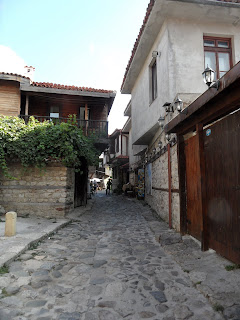August 28, 2011
Never in my life have I seen so many shirtless men outside of a beach. While it may be true that Nessebur has some lovely beaches (and really I have no idea, I’ve only seen them from afar), they are not in the old town and they do not give every man the right to wander around shirtless.
Nessebur (or Nessebar) is essentially a picturesque old town. It has some old Eastern Orthodox churches and the architecture of the old town is appropriately modeled on traditional Bulgarian architecture. The Archeological Museum does a solid job of housing the remnants of the Ancient Thracian, Greek, and Roman cultures that used to call Bulgaria theirs. The area eventually fell under the control of the Byzantines and later the Ottoman Turks, and it is these influences that are most clearly visible in old Nessebur. After WWII Bulgaria, along with the rest of Eastern Europe, fell under the Soviets; but it surprised me that the town did not scream Soviet Oppression the way some Eastern European cities do. I’m not talking about the architecture, you can see the familiar communist cinderblock architecture in the modern portion of Nessebur, the spirit of the town did not scream “We used to be under Soviet rule”. Of course the shops in town sell Soviet memorabilia (pins and watches and such), but mixed in you can see trinkets that celebrate the town’s ancient history and its other modern influences (Bulgaria was at one point under Nazi German control). All in all I had fun (half of which was derived from the freeform driving techniques of the Bulgarians that combines streets packed with pedestrians with cars that could care less about the people around them) walking through the winding streets and perusing the chintzy trinkets and legit antiques and handicrafts that line the roads. It’s not a long visit but it’s totally worth it to check out this funny little UNESCO world heritage site.
And now pictures of the main sites and short descriptions…
St. John Aliturgetos Church
It’s now in ruins, but this church was a fun little stop on the way up from the port into the heart of the old town. Worth pointing out: the mixed masonry. These churches seem to be built out of whatever was lying around, but the masonry does serve a purpose; the different building materials are laid out in such a way as to improve the structural integrity of the building.
The New Metropolitan church
This church was built in the Eastern Orthodox tradition to replace the Old Metropolitan Church (hence the name). That’s pretty much all there is to it. The frescoes are wonderful and the hand-carved wooden throne of the Bishop dates to the 1700s.
The Church of Christ Pantocrator
Another example of the mixed masonry architecture Old Nessebur is famous for, this church was closed on the day I was there. I know you’re thinking “Lauren, you were there on a Sunday; what church is closed on a Sunday?” Apparently this one was turned into an art gallery after it stopped being an active place of worship. And that apparently means they’re closed on Sundays.
Honey
Honey and Roses are the two products that Bulgaria is most famous for. Across from the Church of Christ Pantocrator on the day I was there was a street lined with honey vendors, which was pretty cool. I especially like the guy with the hat.
Ethnographic museum
This is a museum dedicated to traditional Bulgarian culture, as the name would suggest. On display are exhibits of traditional Bulgarian home life, traditional Bulgarian copper working, and traditional Bulgarian textiles all housed in a traditional Bulgarian home. It was a quick stop, but still pretty cool given the setting.
Old Bishop’s Residence and Old Metropolitan Church
This is the big site of old Nessebur. Though it may be in ruins, this building was constructed in the 800s on the foundations of an earlier church dating from the 400s. Its another example of mixed masonry in a church.
Archeological Museum
This was a pretty cool stop. It’s a small museum, but the proprietors are friendly and the exhibits are well labeled. They have two rooms for special exhibits and while I was there the featured a 2010 dig and its findings as well as a collection of Icons and medieval Bulgarian gold on loan from the main archeological museum in Sofia. It is definitely worth stopping as the exhibits are kept up really well and are really quite interesting.
I really enjoyed my day in Nessebur. I picked up some really cool souvenirs (as well as some socks which I somehow managed not to pack). I picked up some Bulgarian pottery bowls (another thing Bulgaria is known for) as well as an old Soviet passbook. The last one is my absolute favorite. I think its really cool that I now own the equivalent of someone’s passport/party membership card (I think her dues are kept track of in the pages of the book). Being a bit of a history nerd with an overactive imagination, it’s especially cool for me to be able to daydream about who this person might have been. Especially since I can’t really read Russian. I can piece out about 85% of the letters, but I have no idea what most of the words mean. If you can read Russian and might be able to tell me what it says, please say so in the comments. I’d love to have it translated.























No comments:
Post a Comment